 Escher's blue Polyommatus escheri© Mike Lockwood Escher's blue Polyommatus escheri© Mike Lockwood
Nature week in the pre-Pyrenees
Wildlife of all shapes and sizes in close-up
The Catalan pre-Pyrenees harbour a wealth of flora and fauna that bears comparison with almost anywhere in the Iberian Peninsula. And Casa Leonardo is the ideal place to come and stay to enjoy it. Our wildlife/nature week consists of six carefully planned days out in the field with Mike Lockwood, a specialized wildlife guide with over 20 of experience guiding groups throughout the Iberian Peninsula and beyond.
Clients who come to our house can choose on which days they go out with Mike according to their interests. On some days the emphasis will be on birds, on others on flowers, on butterflies or on dragonflies. It is a perfect opportunity to observe the wildlife of the Pyrenees at a gradual pace, with plenty of time to photograph all the many wonderful creatures and flowers that we will come across.
Programme
Monday 6 July. Montcortès Lake: a morning visit to one of the most important yet least known wetlands in Catalonia.
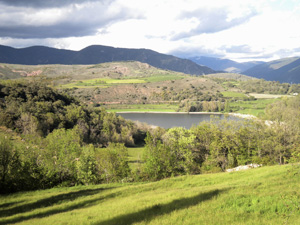 Estany de Montcortès© Mike Lockwood Estany de Montcortès© Mike LockwoodThis karst lake acts as an oasis for many species of flora and fauna and we will be looking above all at the dragonflies and damselflies that haunt this site. In all, 25 species have been identified here and we will have time to walk around the lake, looking at the different micro-habitats, and photograph the species we want. Some of the most interesting species include Blue-eyed hawker Aeshna affinis and Lesser Emperor Anax parthenope, a variety of darters Sympetrum sps. and skimmers Orthetrum sps., as well as damselflies such as Small Spreadwing Lestes virens.
In the afternoon we will continue to look for dragonflies and damselflies in a number of different habitats along the valley of the river Flamisell. Here we will find pincertails Onychogomphus sps. and clubtails Gomphus sps. on or near the river itself, while at small shallow pools we will look for damselflies such as Dainty Coenagrion scitulum and Mercury C. mercuriale Bluets.
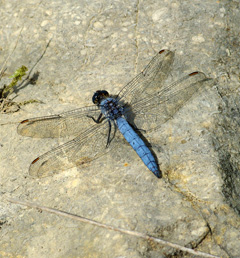 Southern skimmer© Mike Lockwood Southern skimmer© Mike Lockwood
We will also be keeping an eye out for other creatures of interest. The humidity of these dragonfly habitats also attract numerous butterflies – above all, twin-spot fritillary and the blues, Polyommatus sps. – and the whole area is good for forest raptors, Golden Oriole and montane species of bird such as Rock Bunting and Red-backed Shrike.
Tuesday 7 July. The Riqüerna valley: another hidden treasure.
This wild and solitary valley runs north-west from the village of Capdella up to the southern edge of the Aigüestortes National Park. Its south- and north-facing slopes are very different and are home to very different species of flora and fauna. We will walk as far as the waterfall of Salt de Rus along an old trail once used by the drovers who brought their cattle up from the lowlands in summer to feed on the rich upland pastures. If we are in the mood, we can continue on as far as the extraordinarily beautiful lake of Estany Tapat.
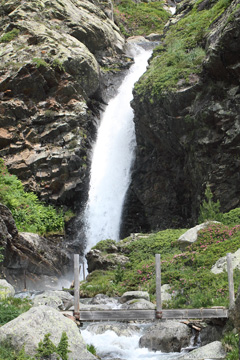 Salt de Rus© Mike Lockwood Salt de Rus© Mike LockwoodThe variety of butterflies in this valley is enormous and we expect to the see the large Apollo Parnassius apollo, one of the most characteristic butterflies of the Pyrenees, as well as a myriad of blues, coppers, hairstreaks, browns and fritillaries, and will have time to photograph and enjoy the scenery of the valley.
The flora of the valley is very varied with as its highlight clumps of Pyrenean lilies, while in terms of the birds, we will be looking out for raptors (including vultures), Yellowhammer, Red-billed and Yellow-billed Choughs, Rock Thrush and Northern Wheatear.
Wednesday 8 July. Coll de Perves and Sant Gervás.
Coll de Pervés at 1,335 m sits on the watershed between the valleys of the river Flamisell and Noguera Ribagorçana, and is a wonderful site for both butterflies and dragonflies. Here we will be able to wander freely through dry limestone grassland populated with myriads of fritillary (Knapweed, Spotted, Glanville, Violet), blues (Turquoise, Chapman's, Escher's, Chalkhill, Mountain Alcon) and other very Pyrenean butterflies (Apollo, Chestnut Heath, Esper's Marbled White, Southern White Admiral, Marbled Skipper, etc.), to a stream with interest dragonfly populations (Dainty Bluet, Red-veined Darter, Southern Skimmer, etc). Overhead, we will be treated to the sight of vulture and eagles that breed on the impressive cliffs in the area; other birds include Rock and Cirl Buntings, Red-back Shrike, Alpine Swift and Peregrine Falcon. 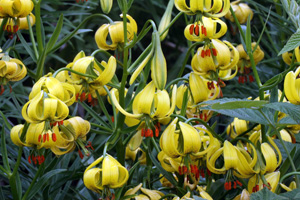 Pyrenean lily Lilium pyrenaicum© Mike Lockwood Pyrenean lily Lilium pyrenaicum© Mike Lockwood
From here we will head onto a secret location that is one of best places in the Iberian Peninsula to see Mountain Small White. This delicate white butterfly is extremely limited in distribution and only appears very occasionally in the pre-Pyrenees. We will look for the clumps of wild lavender and mud puddles that attract a truly incredible diversity of butterflies in the hot summer months. Also of note here are the spiny cushions of Echinospartum horridum, a plant known variously as mother-in-law's cushion or monk's cushion!
Thursday 9 July. Flora and fauna of the Conca de Tremp: the karstic lakes of Basturs.
Despite being essentially an agricultural area, the basin of La Conca de Tremp is rich in small sites of great natural interest for a number of locally rare species of animal and plant. We will start the day alongside the river Noguera Pallaresa, where there is an interesting area of restored habitat that is rich in dragonflies and damselflies. Further on we will visit the karstic lakes at Basturs, a permanent water source in an otherwise dry Mediterranean landscape with a rich avifauna that includes Bee-eater, Hoopoe, Short-toed Eagle and numerous shrub- and scrub-loving warblers and buntings.
 Looking north from Serra de Sant Gervás© Mike Lockwood Looking north from Serra de Sant Gervás© Mike LockwoodFrom the river bottom we will head off to two singular sites, one an area of well-preserved dinosaur footprints and the other the abandoned village of La Rua, perched precariously on a cliff overlooking the valley of the river Rialb. Here too we will visit one of the most southerly beech-forests in Europe with a flora and fauna reminiscent of more northerly latitudes.
And from here, if time permits, we will have a quick look at the Romanesque church of Llordà or the medieval castle of Llordà.
Friday 10 July. Flora and fauna of the Aigüestortes i Sant Maurici National Park.
Our entry into the Aigüestortes National Park will be through its southern and least known route, via La Vall Fosca and the Vall Fosca cable car, which rises over 450 m from its base at the Sallente reservoir to its topmost point at Estany Gento at over 2,100 m. Up high we will pass a large part of our day in a subalpine habitat, almost treeless, which the dominant feature are the granite rocks and the many water courses and lakes. Here we will take advantage of the disused railway track for a comfortable walk.
 Estany Gento cable car© Mike Lockwood Estany Gento cable car© Mike LockwoodHere we will find species of alpine and subalpine plant and animal that normally take a bit of effort to find: rock-jasmines, black vanilla orchids, saxifrages, primulas, lilies and gentians, all accompanied by the many specialist butterfly species of the genera Erebia, Colias, Polyommatus and Argynnis that are adapted to life at such altitude. As well we will find birds equipped to live above the treeline that include species such as Northern Wheatear, Black Redstart, Rock Thrush, Citril Finch, Water Pipit and possibly alpine accentor.
Saturday 11 July (morning only). Visit to vulture feeding station.
To finish off the week, where better than a private vulture feeding station in the heart of the wildest part of the Serra de Boumort? Here we will be able to visit a especially equipped facility, with remote-image cameras, that will give us wonderful views of – we hope – all four of the vulture species that breed in the Iberian Peninsula: Bearded, Black, Griffon and Egyptian. This is the only place in the whole of Europe where these species breed side-by-side and we hope that our morning visit, which is timed to coincide with the supply of food, will bring down these species along with kites, ravens and possibly eagles.
In general, Boumort is a wonderful place for all types of wildlife and there are also abundant populations of Red and Roe Deer, raptors such as Golden and Short-toed Eagles and many forest birds (Crested Tit, Short-toed Treecreeper and Firecrest), as well as a wonderful supply of montane species of butterfly.
This will be a truly fitting way to end our week at Casa Leonardo and our visit to the region of Pallars Jussà.
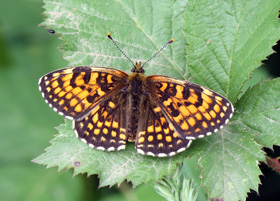 False heath fritillary Melitaea diamina© Mike Lockwood False heath fritillary Melitaea diamina© Mike Lockwood
Nature week in the pre-Pyrenees
Leader: Mike Lockwood
2017 Dates: 5 – 10 June (incl.)
BOOKINGS
Casa Leonardo:
973 661 787
Mike Lockwood:
972 590327 / 661 956 939
Prices
The basic prices are:
– 50€ per person day for ONLY guiding (taxes included).
– For accommodation prices, please contact Casa Leonardo.
Conditions:
- The order of the excursions, their length and content may vary due to changing weather conditions. For example, in case of bad weather we may have to visit more lowland areas.
- Transport will be with clients' own vehicles, although an attempt will be made to fill cars whenever possible.
- The maximum number of people on each excursion is 15.
- We recommend that you dress in appropriate clothing for the activities: lightweight summer clothes, but with long-sleeves to prevent sunburn, hat, stout shoes and waterproof if the weather is threatening, and a warmer layer for the days we go up high.
- The aim of the excursions is the observation, study and photography of the region's wildlife. They are not simple walking routes and so, for example, we may spend an hour at one site looking at the butterflies that are there. Or an hour watching the vultures. The walking rhythm will thus be gentle to allow us to get the best possible views of the wildlife we come across.
- Clients will at all times respect the legal regulations in the areas we visit (i.e. no picking of flowers), as well as the naturalist code of conduct (silence when necessary, patience and respect for animals and plants).
- The visit to the vulture feeding station on Saturday 11 July is only a half-day visit to give people the chance to travel on after lunch. The price of this visit (12€) is NOT included in the overall price.
- The price of the return trip in the cable car (14€) is NOT included.
Please consult our agenda for more planned stays. If you would like to organized a stay for a private group with any particular interest, please get in touch.
|